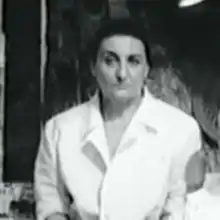Ada Rybachuk
Ada Fedorivna Rybachuk (June 27, 1931 – September 22, 2010) was a Ukraine/Soviet muralist, painter, sculptor and architect. She worked closely with her husband and came to notice when the authorities decided to cancel and destroy a work they had spent ten years creating.
Ada Rybachuk | |
|---|---|
 | |
| Born | June 27, 1931 Kyiv |
| Died | September 22, 2010 |
| Nationality | Ukraine |
| Occupation | Artist |
| Known for | Murals |
| Spouse(s) | Volodymyr Melnychenko |
Biography
Childhood and education
Rybachuk was born in 1931 in Kyiv. Fedir Rybachuk, Ada’s father, personnel officer for the Soviet army, went through the war from the first day to the last one. The rest of the family had to evacuate to Kazakhstan, where Ada finished elementary school. Studied at the Taras Shevchenko Art High School in Kyiv, graduated with highest honours receiving a gold medal. She studied at the Kiev State Art Institute which was led by O. Shovkunenko.[1]
Along with other students takes part in a summer internship lead by Sergei Grosh in Vylkove, located at the delta of Dunai. Sketches created there were shown at the student exhibition, which resulted in the first art order - the creation of illustrations for Dmitry Mamin-Sibiryak’s book “Reindeer Fairy Tales”, published the same year by the Youth Publishing House.[2]
Art
In 1957 Rybachuk completed a sculpture, Shipboy, which shows a youth leaning from a rope ladder as if looking out to sea from a ship.[3] That year she was awarded the silver medal at the "6th world festival of youth and students".[4] She traveled to Armenia Russia and the Ukraine to broaden her studies.[4]
Rybachuk, Volodymyr Melnychenko and the architect Avraam Miletsky began work on a Park of Memory in Kyiv. The Park of Memory was at the local crematorium at Baykoy Hill. The art work covered 2,000 square metres and involved several huge sculptures. Rybachuk and Melnychenko's art work was covered in concrete in 1982 by the authorities and was reported because of the size of this piece of censorship by the authorities. In 1988 Israel Goldstein made a documentary The Wall about their predicament and their campaign to have their work restored.[5]
Rybachuk and her husband worked in a wide range of media including their work at the Palace of Children and Youth in Slavy Square and the Central Bus Station in Kyiv.[6]
Rybachuk died in 2010 in Kyiv.[1] In 2019 there was an exhibition of her work from the 1950s to the 1970s featuring images completed with her husband. The designs were inspired by childhood and the exhibition was called Island. The island represents the gulf between youth and adulthood and between the artist and their censors.[7]
Exhibitions
Private life
Rybachuk was married to her artistic partner Volodymyr Melnychenko.[1] In 2013 he created an exhibition in Kyiv of their work for the National Academy of Arts.[6]
References
- "Soviet Mosaics in Ukraine Rybachuk Ada". Soviet Mosaics in Ukraine. Retrieved 2019-10-13.
- "Rybachuk Ada". UU Archive. Retrieved 2020-10-09.
- "Ada Rybachuk (1931-2010) Shipboy. 1957". Soviet Art (in Russian). Retrieved 2019-10-13.
- "Ada Fedorovna Rybachuk - Biography, Interesting Facts, Famous Artworks". Arthive. Retrieved 2019-10-13.
- "The Wall". travelling.docudays.ua. Retrieved 2019-10-13.
- Agrest-Korotkova, Svitlana (2013). "Fragments of Ada Rybachuk and Volodymyr Melnychenko's eternity". Retrieved 13 October 2019.
- "Ada Rybachuk and Vladimir Melnichenko. Isle". Arthive. Retrieved 2019-10-13.
Literature
- Rybachuk A., Melnychenko V. The Cry of the Bird. II: Fragments. Kyiv: ADEF-Ukraine, 2000. P. 53.
- N. Horova. (2015). Artwork of the first “non-conformists” of the 1950s Ada Rybachuk and Volodymyr Melnychenko. Historiographic and source basis. Hudozhnia kultura. Aktualni problemy: research journal. Modern Art Research Institute of Ukrainian Academy of Arts. Issue 11. Kyiv, Feniks publ., pp. 84–95. (in Ukrainian)